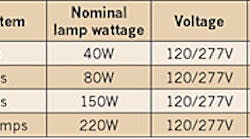In September 2000, the U.S. Department of Energy (DOE) amended the existing conservation standards for fluorescent lamp ballasts when it published standard 10 CFR Part 430, Energy Conservation Program for Consumer Products: Fluorescent Lamp Ballasts Energy Conservation Standards; Final Rule. This rule established new minimum ballast efficacy factor (BEF) levels to take effect in April 2005. Any ballast that did not pass the requirements set forth in this standard would have to be phased out of production and no longer offered for sale in the United States.
Prior to 2005, many industry observers believed the new rules in Part 430 would bring about the virtual demise of magnetic ballasts, and hand the market over to electronic ballasts. However, it was determined that while magnetic ballasts that operated F40T12, F96T12, and F96T12HO lamps failed to meet the new BEF standards set forth in the 2000 rules, ballasts designed to operate energy-saving versions of these lamps were not covered by this regulation. So with support from the National Electrical Manufacturers Association (NEMA), the government revisited the ballast efficiency issue in the Energy Policy of Act of 2005 (EPAct 2005), which President Bush signed into law on Aug. 8, 2005.
Provisions in EPAct 2005 now extend the coverage of these BEF standards to address magnetic ballasts operating energy-saving T12 lamps. The outcome of this latest ruling will finally result in the phased elimination and sale of most magnetic ballasts in new lighting fixtures starting in 2009. The rule takes effect for replacement ballasts in 2010.
“There has been some market confusion following the 2000 DOE ballast rule as to whether ballasts for energy-saving T12 lamps were subject to the federal minimum efficiency requirements,” says Kyle Pitsor, vice president of government relations for NEMA. “In response to this situation, NEMA led an effort to seek clarity on the coverage of the ballasts for energy-saving lamps in the drafting and passage of HR 6, EPAct 2005.”
According to Pitsor, this change now explicitly addresses magnetic ballasts operating energy-saving lamps. The ballast efficacy requirements covering ballasts operating F40T12, F96T12, and F96T12HO lamps, which went into effect on April 1, 2005, are shown in Table 1. The new ballast efficacy requirements, which cover ballasts operating F34T12, F96T12/ES, and F96T12HO/ES lamps, are scheduled to take effect July 1, 2009 (Table 2). Remember, BEF is calculated as follows: [(ballast factor × 100) ÷ system watts]. The higher the number, the more efficient the ballast must be to meet or exceed this factor.
The two timetables that govern the phased withdrawal of ballasts from the market that do not meet the new BEF standards are shown in Table 3. It's important to note that both rules exempt ballasts that are designed for:
-
Dimming to 50% or less of maximum light output,
-
Use with two F96T12HO lamps at ambient temperatures of -20°F and marked for use in outdoor signs, and
-
Labeled for use only in residential applications and operating with a power factor of less than 0.90.
Replacement ballasts will continue to be manufactured and sold until July 1, 2010. These ballasts will feature output leads shorter than the length of the lamp they operate, may be shipped in packages limited to 10 or fewer units, and will be marked, “FOR REPLACEMENT ONLY.”
Although this legislation is considered significant, it's interesting to see that the market has already rapidly accepted the use of electronic ballasts for new fixtures over the last decade. According to the U.S. Economic Census, electronic fluorescent ballasts represented 47% of U.S. sales at the time the ballast regulation was first published in 2000. In 2002, that number rose to 57%. If this adoption rate continues at its current pace, by 2010, magnetic ballasts in new fixtures may already be largely phased out by market preferences.
A significant element of both the original 2000 ballast rule and the new rule included in EPAct 2005, however, is the gradual elimination of the manufacture and sale of replacement magnetic ballasts for full-wattage and energy-saving F40T12, F96T12, and F96T12HO lamps. The end result will be building owners retrofitting or gradually replacing their magnetic ballasts with higher-efficiency ballasts as they fail.
DiLouie is the communications director for the Lighting Controls Association and principal of Zing Communications, Inc., in Calgary, Alberta, Canada.



